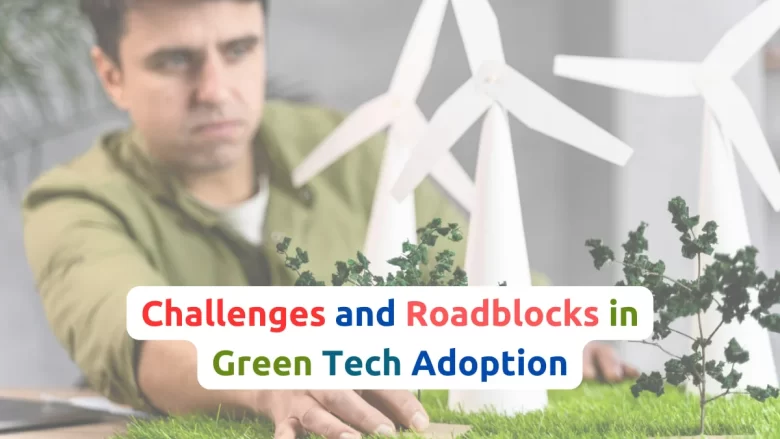Some say that green technology is the key to a more sustainable and cleaner future. Ranging from eco-friendly materials to electric vehicles and renewable energy systems, these breakthroughs have the potential to transform entire industries and reduce our carbon footprint. While green technologies are exciting and offer many benefits, their widespread adoption has not been as rapid or smooth as many expected.
Governments set climate goals, and startups innovate, yet obstacles often impede their practical implementation. A host of issues, including public skepticism, policy gaps, and high initial costs, continue to hamper progress. To overcome these obstacles, you need to understand them. This article discusses the practical barriers that stand in the way of widespread adoption of green technologies and the steps needed to realize their full potential.
Initial Investment Costs Are Too High:
Initial costs are one of the most obvious and pressing barriers to the adoption of green technologies. While energy-efficient systems, electric cars, and solar panels can deliver long-term savings, the initial cost can be a major barrier, especially for small businesses, households, and poor countries. While government subsidies are available, they are not always sufficient or simple to obtain. In addition, installing renewable energy infrastructure, such as wind or solar systems, requires significant capital investment.
Even when leasing or financing options are available, potential buyers may still be hesitant due to the high cost. As long as existing technologies still seem cheaper in the short term, it will be harder for green alternatives to compete. This problem is particularly acute in sectors with low profit margins and long profit cycles, such as construction, transportation, and agriculture. If the cost differential does not continue to narrow, it will be difficult to gain widespread adoption.
Lack of Accessibility and Infrastructure:
The necessary infrastructure is required for green technologies to function effectively. But in many places, this infrastructure is still insufficient. Take electric cars, for example. Although sales of electric vehicles are growing, small towns and rural areas still lack adequate networks of charging stations. Lack of supporting infrastructure hampers customer conversion. Smart grids and renewable energy storage systems are also necessary to fully exploit the benefits of solar and wind energy.
However, progress in this area often lags due to financial and logistical constraints. In poor countries, the gap is even greater, as access to capital, technology, and expertise is limited. Even in rich countries, such a change would require massive reforms of existing systems, costing billions of dollars and taking years of planning. A large part of the population still lacks access to green technologies due to the absence of the necessary ecosystems.
Policy Gaps and Regulatory Uncertainty:
While governments have significant influence on the development of green technology industries, vague or uneven regulations often lead to hesitation and uncertainty. Some regions already have strong and comprehensive green energy legislation. In other cases, these policies are out of step with the political cycle, fragmented, or poorly implemented. This uncertainty makes it difficult for companies to invest confidently in green technologies.
For instance, companies might be hesitant to invest in solar energy infrastructure if they anticipate the elimination of tax breaks following the elections. The absence of global guidelines for emissions, carbon credits, and sustainability measures also leads to an imbalance in the market. Policy delays also slow down the development of innovative technologies that rely on government funding or licensing. Without good and stimulating regulation, it is difficult for the green technology sector to develop and innovate.
Scalability Issues and Technical Limitations:
Not all green technologies are suitable for widespread adoption. Some technologies are still in their early stages of development or do not function as well as traditional technologies. For example, hydrogen fuel cells show enormous promise, but the technology is still expensive, and there is no large infrastructure for it. Although battery technology for energy storage has made significant progress, problems such as resource scarcity, degradation, and capacity limitations still exist.
Improved recycling systems, carbon capture, and biofuels also have potential, but are not sufficient to replace existing systems. These technologies often work well in pilot programs or controlled environments, but they show shortcomings in practice when deployed at scale. Until these technological gaps are filled, industries will be reluctant to embrace green alternatives that may not meet their operational needs.
Public Perception and Oppositional Behavior:
Even the best technology will fail if people are not willing to use it. The acceptance of green technology is strongly influenced by public opinion. Several factors, such as resistance to change, ignorance, and misinformation, contribute to the slow growth. Although this perception has changed, many buyers still view green products as less dependable, less expensive, or less convenient.
There is also a psychological barrier: people are naturally averse to investing in new systems and changing their daily routines. In some circles, green technology is wrongly associated with elite or political goals, further dividing public opinion. To win the hearts and minds of the people, we must use media, education, and community activities to help them see the real benefits of green technology. Without cultural engagement, even the most advanced technology will not work.
Conclusion:
A sustainable, prosperous future is possible through green technology, but achieving it is more complicated than just flipping a switch. The real barriers that must be addressed include high costs, inadequate infrastructure, poor regulation, technological limitations, and human resistance. While innovation is moving at a rapid pace, adoption is a separate issue that requires collaboration between the public, businesses, and governments. To overcome these barriers, we need to invest in infrastructure, education, and policy changes in addition to technology. While the road to a green future is long and complicated, it is worth it. Focus and effort can transform these obstacles into steps that lead to meaningful and lasting transformation.
FAQs:
1. Why are some countries slower to adopt green technology than others?
The slow pace of adoption is due to several factors, especially in poor countries, including lack of infrastructure, insufficient financing, inadequate policy frameworks, and low public awareness.
2. Is green technology pricier?
Although green technologies often have higher initial costs, many solutions ultimately become more cost-effective over time as energy and maintenance costs decrease.
3. How does the government influence the adoption of green technology?
Regulation, subsidies, government investment, and policies that encourage innovation and reduce risks for consumers and businesses are some of the ways governments influence adoption.
4. How can we promote the use of green technology?
Strong infrastructure, accessible financing, incentives, and education can all help build trust and make green technologies more attractive to the average consumer.
5. Which sectors face the greatest barriers to greening?
Industries such as manufacturing, construction, transportation, and agriculture often face the greatest barriers due to high costs, long equipment lifespans, and heavy reliance on fossil fuels.




